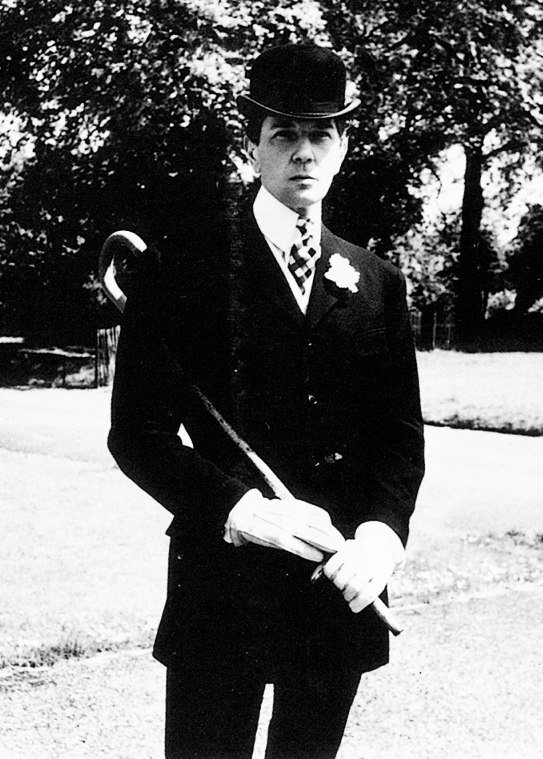 Bunny Roger
Bunny Roger
By Clive Fisher
The Independent, 1997
Erstwhile couturier, wit, dandy, landowner, and social ornament, Bunny Roger was what obituary in its obliquer days styled a lifelong bachelor and what gossip columnists knew as a flamboyant homosexual. Not that the phraseology of old Fleet Street would have distressed him: he was nothing if not implacably conservative and as the last of a kind he could scarcely expect new labels. Equally, the Queen’s English (like anything else remotely royal) deserved veneration and there was one term he always resisted: “You can’t call queer men ‘gay.’ Apart from anything else, they’re all so miserable. The Greeks were more accurate when they called the Furies the ‘Kindly Ones’.” Yet Bunny himself — so styled from infancy when his nanny imagined a likeness — was far from morose. As the second of Sir Alexander and Lady Roger’s three sons he determined precociously to wrest parental attention from his better-placed siblings and all his life he retained a showman’s resilience, an enthusiast’s energy and a conviction that life is what one makes it. His father was a City tycoon, self-made, Aberdonian, a magnate in international telecommunications, while his mother, also Scotch, was an extravagant beauty whose portrait by William Acton later surveyed Roger’s drawing-room.
What they can have been thinking when they gave their six-year-old middle son a fairy’s costume of filmy skirts and butterfly wings, with the promise of a wand to further his caperings, it is hard to imagine; but the Rogers were a happy family and by the early Thirties, the Depression notwithstanding, they were also a wealthy one, and lived in opulence at Ewhurst Park in Hampshire as tenants of the Duke of Wellington.
Following a miserable schooling at Loretto outside Edinburgh, Roger read History at Balliol under F. F. Urquhart. “The Sligger’s” celebrated Alpine reading parties failed to entice, and Roger instead joined Ouds (thereby meeting his lifelong friend Terence Rattigan) and danced the Charleston with any compliant Rugby Blue. After a year, determined on a career designing clothes, he left Balliol for drawing classes at the Ruskin. Rouge and hair dye enlivened his prettiness and soon he passed as an unthreatening sweetheart among the virgin, girl-shy undergraduates. Osbert Lancaster presented him with a pekinese puppy; others pressed more unequivocal suits; but the authorities were watching and Roger was summoned before a donnish tribunal, accused of corrupting homosexual activities and banished from Oxford.
America he found disappointing and disenchantment was compounded when in Hollywood he was likened to the young George Arliss and not the next Marlene Dietrich. He crossed Hitler’s Germany in one of his father’s Rolls Royces to visit a cousin in Poland. He frequented London parties (although stories that he and his brothers attended a Chelsea Arts Club ball as the Bronte sisters were apocryphal). He befriended and patronised the young Edward Burra. As an assistant in the studio at Waring and Gillow he helped furnish King Zog’s palaces; later, at Fortnum’s tailoring, he learnt about costing and cutting.
Finally, with encouragement and advice from Edward Molyneux and Victor Stiebel and pounds 1,000 backing from his father, he opened his own dress-making establishment, Neil Roger, in Great Newport Street in 1937. The showroom was decorated in Regency Gothic and for his first collection Roger invited everyone mentioned in the current Tatler and disguised his boldness by scrawling across each invitation the fictitious assurance, “Mary asked me to send you this.” He numbered among his clients the Lygon sisters, Vivien Leigh and Princess Marina.
During the Second World War, conspicuously rouged in the Rifle Brigade, he saw active service in Italy and North Africa and after being demobbed he set up a new establishment in Bruton Mews before being invited to run the couture department at Fortnum’s. Presently, with his friend Hardy Amies financially precarious, he invested a generous sum in the House of Amies and for a while operated from there. His investment was handsomely vindicated when Debenhams acquired his holding and he retired in 1973.
Besides, party-giving, which happily combined Roger’s passions for dancing and dressing up, had long constituted a second vocation. With his younger brother Sandy he had moved in 1946 to Walton Street and their large house, with its basement murals depicting a Highland Garden of Eden, soon became a celebrated, if louche, nocturnal destination. Their 1952 “Quo Vadis?” party, with no address supplied on the invitation, saw Bunny Roger scantily clad for slavery. The year 1953 marked the Coronation Ball, with its host bejewelled as Queen Alexandra, and 1956 the notorious Fetish Party, which provoked full-page dismay in the People. In their day these extravaganzas were outrageous; and even at the Diamond, Amethyst and Flame Balls, given to celebrate his 60th, 70th and 80th birthdays, Roger outshone and outdanced his guests from the worlds of theatre and fashion.
He dispensed sedater hospitality at Dundonnell, the estate in Wester Ross he shared with his brothers. A phenomenon of energy, even in his eighties, he interrupted his constant cooking, talking and card-playing to show guests the famous Chinese gardens created by his brother Alan or to don yet another astonishing suit. He was, after all, a Savile Row institution and his 150 suits catered, albeit theatrically, for every contingency.
He invented the tight-cut Capri trousers while on holiday on the island in 1949 and by the Fifties he was sponsoring a neo-Edwardian silhouette — four-button jackets with generous shoulders and mean waists, lapelled waistcoats, high-cut trousers — for plain, checked and striped suits. Accessories, whether a high-crowned bowler or ruby cuff-links, were indispensable; and even in his eighties the final effect, with Roger’s eight-stone frame and white, much-lifted face turned vain singularity to artistry.
All dandies need an audience but Bunny Roger inspired what almost amounted to a following — partly because by word and deed he never stopped entertaining; partly because we are all nostalgic for style. Most crucially, however, he was true: beneath his mauve mannerisms he was stalwart, frank, dependable and undeceived; to onlookers a passing peacock, to intimates a life enhancer and exemplary friend.
Neil Munroe (“Bunny”) Roger, couturier: born London 9 June 1911; died London 27 April 1997.
